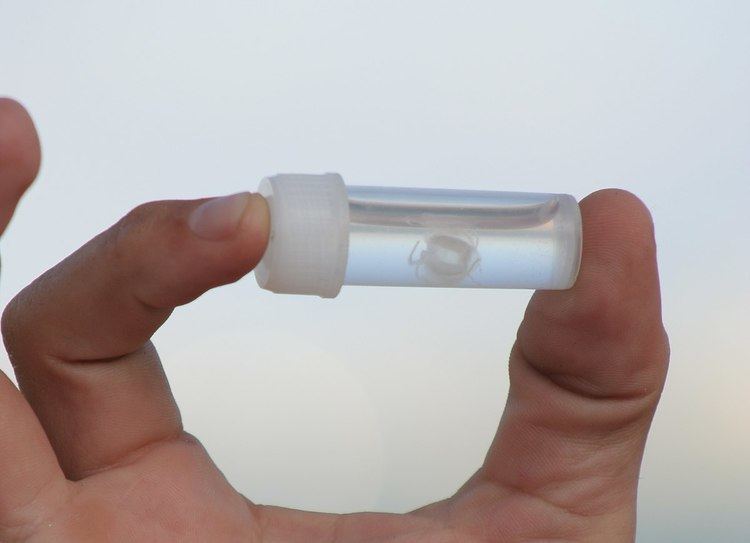 | ||
Irukandji syndrome is a condition induced by venomization by the sting of Carukia barnesi, a species of Irukandji jellyfish, and certain other box jellyfish. Unless immediate medical action is taken, victims can go into cardiac arrest and die. The syndrome was given its name in 1952 by Hugo Flecker, after the Aboriginal Irukandji people who live in Palm Cove, north of Cairns, Queensland, Australia, where stings are common.
Contents
Early experience
In 1964 Jack Barnes confirmed the cause of the syndrome was a sting from a small box jellyfish: the Irukandji jellyfish, which can fire venom-filled stingers out of its body and into passing victims. To prove that the jellyfish was the cause of the syndrome, he captured one and deliberately stung himself. His son and a local lifeguard then observed the resulting symptoms (before being rushed to the ICU.) Other cubozoans possibly can cause Irukandji syndrome; those positively identified include Carukia barnesi, Alatina cf. mordens, Alatina alata, Malo maximus, Malo kingi, Carybdea xaymacana, an as-yet unnamed "fire jelly", and another unnamed species.
Toxicity
When properly treated, a single sting is normally not fatal; however, two people in Australia are believed to have died from Irukandji stings, which has greatly increased public awareness of Irukandji syndrome. It is unknown how many other deaths from Irukandji syndrome have been wrongly attributed to other causes. The exact mechanism of action of the venom is known. Animal studies appear to confirm a relationship between envenoming and an increase in circulating noradrenaline and adrenaline.
Symptoms
Most stings occur during the summer wet season in October–May in North Queensland, with different seasonal patterns elsewhere. Because the jellyfish is very small, and the venom is only injected through the tips of the nematocysts (the cnidocysts) rather than the entire lengths, the sting may barely be noticed at first. It has been described as feeling like little more than a mosquito bite. The symptoms, however, gradually become apparent and then more and more intense in the subsequent five to 120 minutes (30 minutes on average). Irukandji syndrome includes an array of systemic symptoms, including severe headache, backache, muscle pains, chest and abdominal pain, nausea and vomiting, sweating, anxiety, hypertension, tachycardia and pulmonary edema. One unusual symptom associated with the syndrome is a feeling of "impending doom". Patients have been reported as being so certain they are going to die, they beg their doctors to kill them to get it over with. Symptoms generally abate in four to 30 hours, but may take up to two weeks to resolve completely.
Treatment
Similar to other box jellyfish stings, first aid consists of flushing the area with vinegar to neutralize the tentacle stinging apparatus. As no antivenom is available, treatment is largely supportive, with analgesia being the mainstay of management. Glyceryl trinitrate, a common drug used for cardiac conditions, is utilised by medical personnel to minimise the risk of pulmonary edema and to reduce hypertension. Antihistamines may be of benefit for pain relief, but most cases require intravenous opioid analgesia. Fentanyl or morphine are usually chosen. Pethidine (meperidine, brand name Demerol in the US) should be avoided, as large doses are often required for pain relief and in this situation significant adverse effects from the pethidine metabolite norpethidine may occur.
Magnesium sulfate has been proposed as a treatment for Irukandji syndrome after being apparently successfully used in one case. Early evidence suggested a benefit; however, according to a later report, a series of three patients failed to show any improvement with magnesium; the author reiterated the experimental status of this treatment. Some preliminary laboratory experiments using the venom extracted from Malo maxima (the 'Broome Irukandji') on rat cardiovascular tissue in vitro has suggested that magnesium does in fact block many of the actions of this venom.
Geographic distribution
Reports of Irukandji syndrome have come from Australia, Hawaii, Florida, the French Antilles, Bonaire, the Caribbean, Timor Leste and Papua New Guinea. Cubozoan species other than Carukia barnesi are presumed to be responsible for envenomations outside Australia.
Media portrayals
A 2005 Discovery Channel program, Killer Jellyfish, portrayed the severity of the pain from an Irukandji jellyfish sting when two Australian researchers (Jamie Seymour and Teresa Carrette) were stung. Another program aired on the Discovery Channel, Stings, Fangs and Spines, featured a 20-minute spot on Irukandji syndrome. In the segment, a young Australian woman was stung and developed a severe case.
A 2007 Sea Patrol episode (S1, E4), involves the Irukandji Jellyfish. Two of HMAS Hammersley's crew, Jaffa and Cheffo, are stung by the jellyfish when recovering the seaboat. Charge is also stung on the eye but it is not life threatening. Jaffa eventually dies from the sting. Cheffo and Charge both recover from the sting.
On the television program Super Animal, a woman compared her experience with Irukandji syndrome to the pain from childbirth.
Steve Backshall reports with accounts from victims of Irukandji stings on his ITV wildlife series Fierce in 2016.
